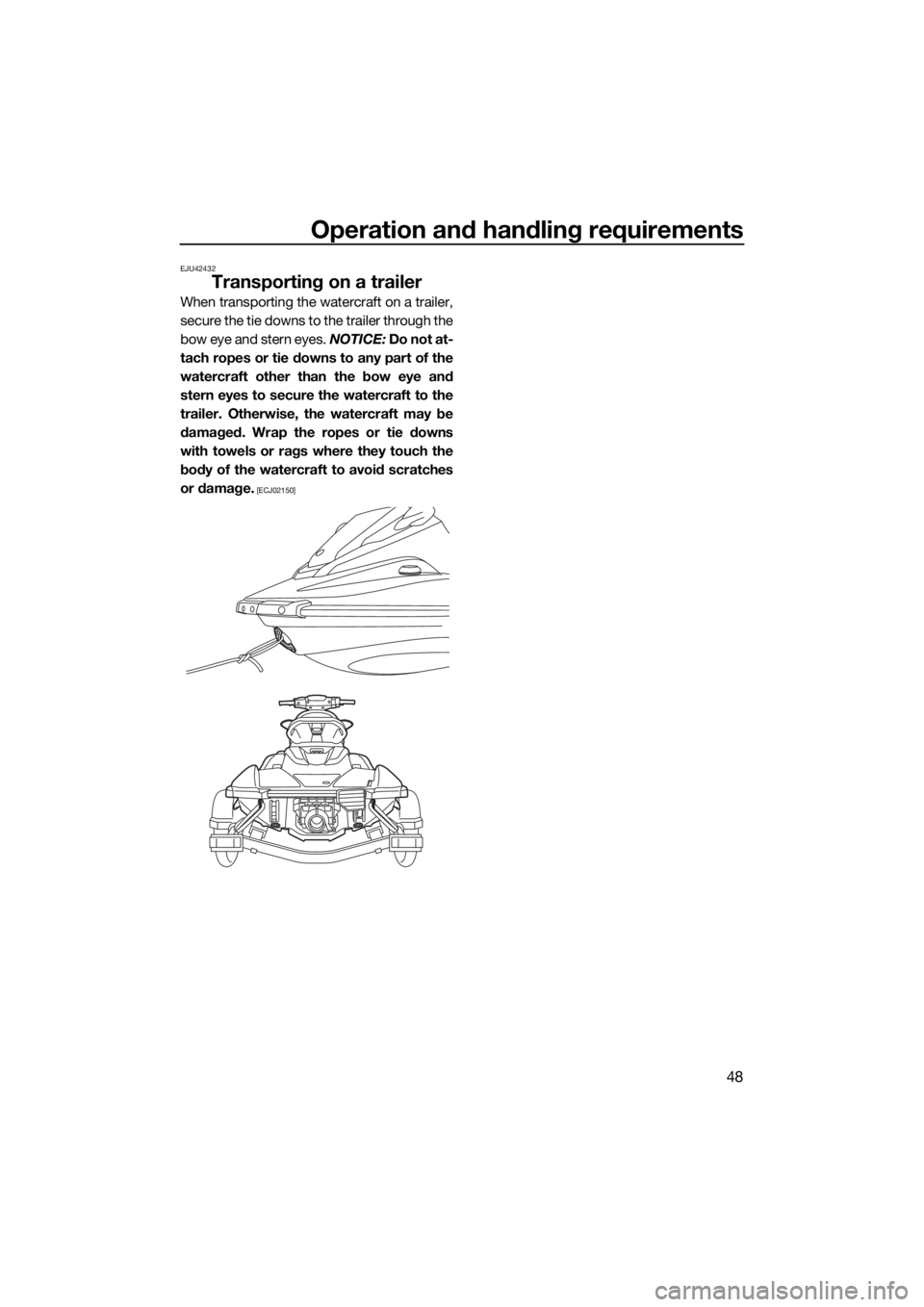tow YAMAHA EXR 2021 Owners Manual
[x] Cancel search | Manufacturer: YAMAHA, Model Year: 2021, Model line: EXR, Model: YAMAHA EXR 2021Pages: 98, PDF Size: 4.56 MB
Page 7 of 98

Table of contents
Learning to operate your watercraft ...................................... 59
Riding position ................................. 60
Launching the watercraft ................. 60
Starting the engine on water ............ 60
Stopping the engine ......................... 61
Leaving the watercraft...................... 61
Operating the watercraft .................. 61
Turning the watercraft ...................... 62
Stopping the watercraft ................... 63
Operating the watercraft in reverse or neutral ...................................... 64
Boarding the watercraft ................... 65
Starting off........................................ 67
Capsized watercraft ......................... 68
Beaching and docking the watercraft ...................................... 69
Operating in weeded areas .............. 69
After removing the watercraft from the water ....................................... 70
Care and storage............................. 71Post-operation care ...................... 71
Flushing the cooling water
passages....................................... 71
Cleaning the watercraft .................... 72
Battery care ...................................... 72
Long-term storage ........................ 74
Cleaning ........................................... 74
Lubrication ....................................... 74
Rustproofing..................................... 75
Maintenance .................................... 77 Maintenance.................................. 77
Periodic maintenance chart ............. 78
Engine oil and oil filter ...................... 80
Specifications .................................. 81Specifications................................ 81
Trouble recovery ............................. 82 Troubleshooting ............................ 82
Troubleshooting chart ...................... 82
Emergency procedures ................ 85
Cleaning the jet intake and
impeller ......................................... 85
Raising the reverse gate .................. 86
Jumping the battery ......................... 86
Towing the watercraft....................... 87
Submerged watercraft ..................... 87
Index................................................. 89
UF4L72E0.book Page 2 Thursday, June 18, 2020 1:29 PM
Page 20 of 98

Safety information
13
tercraft to avoid accidental starting or un-
authorized use by children or others.
Scan carefully for swimmers and stay away
from swimming areas. Swimmers are hard
to see and you could accidentally hit some-
one in the water.
Avoid being hit by another boat. You
should always take the responsibility to
watch for traffic; other boaters may not be
watching for you. If they do not see you, or
if you maneuver more quickly than other
boaters expect, you risk a collision.
Maintain a safe distance from other boats
and watercraft, and also watch for ski
ropes or fishing lines. Obey the “Safe boat-
ing rules” and be sure to check behind you
before making a turn or slowing down. (See
“Safe boating rules” on page 17.)
EJU30841
Recommended equipment
The following items should be carried on
board your watercraft:
Sound-signaling device
You should carry a whistle or other sound-
signaling device that can be used to signal
other boats.
Visual distress signals
It is recommended that a pyrotechnic de-
vice, which is approved by the appropriate
authorities, be stored in a waterproof con-
tainer on your watercraft. A mirror can also
be used as an emergency signal. Contact a
Yamaha dealer for more information.
Watch
A watch is helpful so you will know how
long you have been operating the water-
craft.
Towline
A towline can be used to tow a disabled
watercraft in an emergency.
UF4L72E0.book Page 13 Thursday, June 18, 2020 1:29 PM
Page 24 of 98

Safety information
17
er’s or water-skier’s ability, as well as water
and weather conditions.
When preparing to pull a wakeboarder or
water-skier, operate the watercraft at the
slowest possible speed until the watercraft
is well away from the person being pulled
and slack in the ski rope is taken up. Make
sure that the rope is not looped around
anything.
After checking that the wakeboarder or wa-
ter-skier is ready and that there is no traffic
or other obstacles, apply enough throttle to
raise the person.
Make smooth, wide turns. The watercraft is
capable of very sharp turns, which could
exceed the abilities of the wakeboarder or
water-skier. Keep the person being towed
at least 50 m (164 ft), about twice the dis-
tance of a standard ski rope, away from
any potential hazard.
The operators of boats and other water-
craft may not be aware that you are pulling
a wakeboarder or water-skier. Together
with the spotter, pay attention to others
around you and cruise at safe speeds.
Be alert to the hazard of the ski rope handle
snapping back at the watercraft when the
wakeboarder or water-skier falls or is un-
able to get up.
Towing heavy or bulky objects other than
wakeboarders or water-skiers, such as an-
other boat or watercraft, can cause loss of
steering control and create a hazardous
condition. If you must tow another boat in
an emergency situation, operate slowly
and cautiously.
EJU30971
Safe boating rules
Your Yamaha watercraft is legally considered
a powerboat. Operation of the watercraft
must be in accordance with the rules and
regulations governing the waterway on which
it is used.
UF4L72E0.book Page 17 Thursday, June 18, 2020 1:29 PM
Page 45 of 98

Equipment operation
38
EJU34873Bow eye
The bow eye is used to attach a rope to the
watercraft when transporting, mooring, or
towing it in an emergency. (See page 87 for
information on towing the watercraft.)
EJU34882Stern eyes
The stern eyes are used to attach a rope to
the watercraft when transporting or mooring
it.
EJU40423Cleat
The cleat is used to attach a ski rope to the
watercraft when pulling a wakeboarder or
water-skier. WARNING! Do not use the
cleat to lift the watercraft. The cleat is not
designed to support the watercraft’s
weight. If the cleat breaks, the watercraft could fall, which could result in severe in-
jury.
[EWJ01511]
EJU31685
Storage compartments
This watercraft is equipped with the following
storage compartments.
The storage compartments are not designed
to be waterproof. If you carry objects that
must be kept dry, put them in a waterproof
bag.
Make sure that the storage compartments
are closed securely before operating the wa-
tercraft.
EJU44660Bow storage compartment
The bow storage compartment is located un-
der the hood.
1 Bow eye
1 Stern eye
1
1
1Cleat
1
UF4L72E0.book Page 38 Thursday, June 18, 2020 1:29 PM
Page 55 of 98

Operation and handling requirements
48
EJU42432
Transporting on a trailer
When transporting the watercraft on a trailer,
secure the tie downs to the trailer through the
bow eye and stern eyes. NOTICE: Do not at-
tach ropes or tie downs to any part of the
watercraft other than the bow eye and
stern eyes to secure the watercraft to the
trailer. Otherwise, the watercraft may be
damaged. Wrap the ropes or tie downs
with towels or rags where they touch the
body of the watercraft to avoid scratches
or damage.
[ECJ02150]
UF4L72E0.book Page 48 Thursday, June 18, 2020 1:29 PM
Page 76 of 98

Operation
69
on the gunwale with your other hand or
your foot.
(3) Start the engine and operate the water- craft at planing speed to drain the bilge
water from the engine compartment.
(See page 46 for information on draining
the bilge water. If the engine does not
start, see “Towing the watercraft” on
page 87 or “Submerged watercraft” on
page 87.) NOTICE: Do not run the en-
gine at full throttle for at least 1 minute
after the engine has been restarted.
Bilge water in the engine compart-
ment can splash into the engine,
which can result in severe damage.
[ECJ00554]
EJU43282
Beaching and docking the watercraft
To beach the watercraft:
(1) Make sure that there are no boats, swim- mers, or obstacles near the beach. (2) Release the throttle lever to reduce
speed about 100 m (330 ft) before you
reach the intended beaching area.
(3) Slowly approach the beach using the throttle lever and RiDE lever to control
the watercraft speed. NOTICE: Never
run the engine in water that is less
than 60 cm (2 ft) deep from the bottom
of the watercraft, otherwise pebbles
or sand could be sucked into the jet
intake, causing impeller damage and
engine overheating.
[ECJ00473]
(4) After reaching land, stop the engine, and then get off the watercraft and pull it up
on the beach.
To dock the watercraft:
(1) Make sure that there are no boats, swim- mers, or obstacles near the dock.
(2) Release the throttle lever to reduce speed about 100 m (330 ft) away from
the dock.
(3) Slowly approach the dock using the throttle lever and RiDE lever to control
the watercraft speed.
(4) After coming alongside the dock, stop the engine, and then get off the water-
craft.
EJU37194Operating in weeded areas
Always avoid using your watercraft in areas
where weed growth is thick. If operating in
weeded areas is unavoidable, alternately
squeeze the throttle lever and relax your grip
on the throttle lever to vary the engine speed.
Weeds tend to become clogged more when
operating at a steady speed and at trolling
speed. If weeds may have clogged the intake
area, clean the jet intake. (See page 85 for in-
formation on the jet intake.)
UF4L72E0.book Page 69 Thursday, June 18, 2020 1:29 PM
Page 93 of 98

Trouble recovery
86
ler, jet pump housing, and jet thrust noz-
zle.
If debris is difficult to remove, consult a
Yamaha dealer.
EJU43472Raising the reverse gate
If the RiDE system malfunctions and the re-
verse gate remains in the lowered position,
the watercraft will not be able to move for-
ward.
After raising the reverse gate so that the wa-
tercraft can move forward, immediately re-
turn to shore and have a Yamaha dealer
service the watercraft.
To raise the reverse gate:
(1) Stop the engine and remove the clip from the engine shut-off switch.
(2) Enter the water and move to the rear of the watercraft.
(3) Slide the shift rod joint toward the bow, and then disconnect the shift rod joint
from the ball joint. (4) Raise the reverse gate to the forward po-
sition.TIP:
While the shift rod is disconnected, the re-
verse gate will not move to the neutral po-
sition or reverse position even if the RiDE
lever is squeezed.
If the RiDE lever is squeezed while the shift
rod is disconnected, the watercraft will
move forward.
EJU34642Jumping the battery
If the watercraft battery has run down, the en-
gine can be started using a 12-volt booster
battery and jumper cables.
EJU34664Connecting the jumper cablesEWJ01251
To avoid battery explosion and serious
damage to the electrical system:
Do not reverse the polarity of the jumper
cables when connecting to the batter-
ies.
Do not connect the negative (–) jumper
cable to the negative (–) terminal of the
watercraft battery.
Do not touch the positive (+) jumper ca-
ble to the negative (–) jumper cable.
1Shift rod joint
2 Ball joint
1 2
1
Reverse gate
2 Forward position
1
2
UF4L72E0.book Page 86 Thursday, June 18, 2020 1:29 PM
Page 94 of 98

Trouble recovery
87
(1) Connect the positive (+) jumper cable tothe positive (+) battery terminals of both
batteries.
(2) Connect one end of the negative (–) jumper cable to the negative (–) battery
terminal of the booster battery.
(3) Connect the other end of the negative (–) jumper cable to an engine hanger.
(4) Start the engine, and then disconnect the jumper cables by reversing the steps
above. (See page 24 for information on
starting the engine.)
EJU34716Towing the watercraftEWJ00812
The operator of the towing boat must
keep speed to a minimum and avoid
traffic or obstacles which could be a
hazard to the operator on the water-
craft.
The towline should be long enough so
that the watercraft will not collide with
the towing boat when slowing down.
If the watercraft becomes inoperative in the
water, it can be towed to shore. To tow the watercraft:
Use a towline that is three times the com-
bined length of the towing boat and the wa-
tercraft.
(1) Securely attach the towline to the bow
eye of the watercraft being towed.
(2) Sit astride the seat and hold on to the handlebars in order to balance the water-
craft. NOTICE: The bow must be kept
up out of the water during towing, oth-
erwise water could flood the engine
compartment or water could flow
back into the engine, causing severe
engine damage.
[ECJ01331]
Tow the watercraft at 8 km/h (5 mph) or less.
NOTICE: Tow the watercraft at 8 km/h (5
mph) or less, otherwise water could flood
the engine compartment or water could
flow back into the engine, causing severe
engine damage.
[ECJ01322]
EJU42101
Submerged watercraft
If the watercraft is submerged or flooded with
water, drain the bilge water from the engine
compartment. Then, have a Yamaha dealer
service the watercraft as soon as possible.
If the watercraft was submerged:
(1) Remove the watercraft from the water and drain the water from the storage
compartments.
1Positive (+) jumper cable
2 Booster battery
3 Negative (–) jumper cable
4 Engine hanger
123
4
1Bow eye
1
UF4L72E0.book Page 87 Thursday, June 18, 2020 1:29 PM
Page 97 of 98

Index
90
Manufactured date label ............................ 2
Model information ...................................... 2
Multifunction information center .............. 31
Multifunction information center check ... 57
O
Oil pressure warning ................................ 34
Operating in weeded areas ...................... 69
Operating the watercraft .......................... 61
Operating the watercraft in reverse or neutral ................................................... 64
Operating your watercraft ........................ 59
Operation requirements ........................... 11
P
Periodic maintenance chart ..................... 78
Post-launch checks ................................. 57
Post-operation care ................................. 71
Pre-launch checks ................................... 52
Pre-operation check points ..................... 52
Pre-operation checklist ............................ 50
Primary Identification (PRI-ID) number ...... 1
R
Raising the reverse gate .......................... 86
Reboarding grip ....................................... 37
Reboarding step ...................................... 37
Recommended equipment ...................... 13
RiDE lever................................................. 25
RiDE lever checks .................................... 54
Riding position ......................................... 60
Rustproofing ............................................ 75
S
Safe boating rules .................................... 17
Safety equipment check .......................... 56
Seat .......................................................... 36
Seat storage compartment ...................... 40
Shift indicator ........................................... 32
Shift system ............................................. 28
Shift system check................................... 58
Speedometer ........................................... 31
Start switch .............................................. 24
Starting off ............................................... 67
Starting off from a trailer .......................... 68
Starting the engine on water .................... 60
Steering system ....................................... 25
Steering system checks ........................... 54
Stern drain plug checks ........................... 56 Stern eyes ................................................ 38
Stopping the engine ................................. 61
Stopping the watercraft ........................... 63
Storage compartment checks.................. 56
Storage compartments ............................ 38
Submerged watercraft ............................. 87
Switch checks .......................................... 55
T
Tachometer .............................................. 32
Throttle lever ............................................ 25
Throttle lever checks ................................ 55
Towing the watercraft .............................. 87
Transporting on a trailer ........................... 48
Troubleshooting ....................................... 82
Troubleshooting chart .............................. 82
Turning the watercraft .............................. 62
W
Wakeboarding and water-skiing .............. 16
Water separator ....................................... 26
Water separator check ............................. 53
Watercraft characteristics ........................ 14
Watercraft control functions..................... 24
Watercraft operation functions ................ 28
UF4L72E0.book Page 90 Thursday, June 18, 2020 1:29 PM